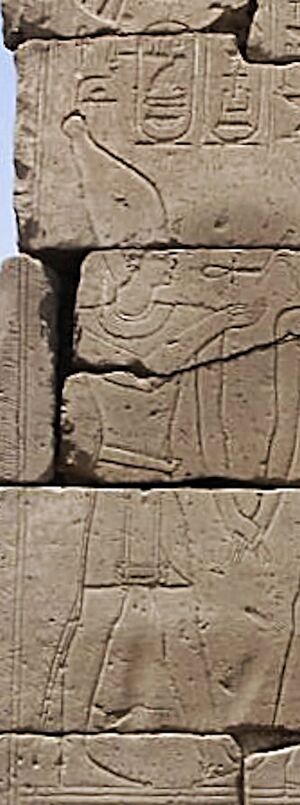Psamtik III facts for kids
Quick facts for kids Psamtik III |
|
|---|---|
| Psammetichus III | |

Relief depicting Psamtik III from a chapel in Karnak
|
|
| Pharaoh | |
| Reign | 526–525 BC (26th dynasty) |
| Predecessor | Amasis II |
| Successor | Cambyses II, Second Ruler of Persia |
| Children | Amasis |
| Died | 525 BC |
Psamtik III was the last Pharaoh of the Twenty-sixth Dynasty of Egypt. He ruled ancient Egypt for a short time, from 526 BC to 525 BC. Most of what we know about Psamtik III comes from the Greek historian Herodotus. Herodotus wrote that Psamtik III was pharaoh for only six months. During this time, his country was invaded by the powerful Persian army. This army was led by King Cambyses II of Persia. Psamtik III and his forces were defeated in a major battle. He then fled to the city of Memphis, where he was captured. Psamtik III was taken to Susa, a city in Persia, and later died while imprisoned.
Contents
Who Was Psamtik III?
Psamtik III was the son of the pharaoh Amasis II. His mother was Queen Tentkheta. Psamtik III became pharaoh in 526 BC. This happened after his father, Amasis II, passed away. Amasis II had been a very successful ruler for about 44 years. According to Herodotus, Psamtik III had a son named Amasis. He also had a wife and a daughter, but their names are not known from historical records.
The Persian Invasion of Egypt
Psamtik III's rule lasted for only six months. Soon after he became pharaoh, a rare rainstorm happened in the city of Thebes. Some Egyptians saw this as a bad sign for the new ruler. Psamtik III was young and did not have much experience. He faced a huge challenge from the invading Persian army.
The Battle of Pelusium
The Persian army, led by King Cambyses II, crossed the Sinai desert. They were helped by the Arabian people. In the spring of 525 BC, a fierce battle took place. It was fought near Pelusium, a city on Egypt's eastern border. The Egyptian forces were defeated in this battle. Psamtik III was also betrayed by one of his allies, Phanes of Halicarnassus.
Capture and Imprisonment
After the defeat, Psamtik III and his army had to retreat to Memphis. The Persians then surrounded Memphis and began a long siege. Eventually, the city fell, and Psamtik III was captured. After the city was taken, King Cambyses ordered the execution of many important citizens. This included, it is said, one of Psamtik III's sons.
Images for kids


